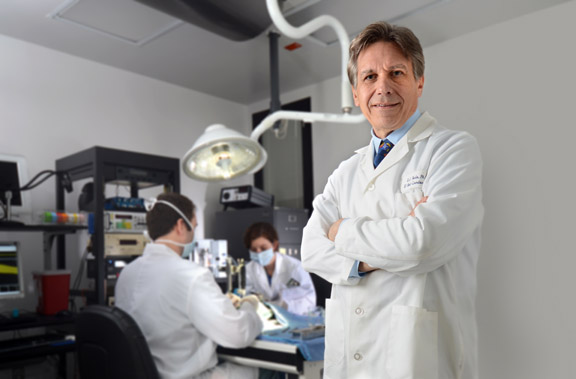KU researcher helps develop implant that can restore brain function in rats

Kansas University School of Medicine professor and neurobiologist Randalph Nudo holds a tiny device that helped restore motor skills in brain-damaged mice. Photo courtesy of KU.

Randolph Nudo is a Kansas University School of Medicine professor and director of the Landon Center on Agin at the KU Medical Center. Photo by Elissa Monroe/KU Medical Center
Using a 3-by-3 millimeter device powered by a conventional watch battery, a Kansas University School of Medicine researcher and colleagues have developed an implant that restored motor skills in rats with brain damage.
The scientists who worked on the study think the implant could one day lead to devices that help restore brain function in people who have suffered strokes and head injuries.
Randolph Nudo, a KU professor of molecular and integrative phsyiology and director of the Landon Center on Aging at the KU Medical Center, is senior author of a study published in the Proceedings of the National Academy of Sciences. Nudo and Pedram Mohseni, a professor of electrical engineering and computer science at Case Western Reserve University in Cleveland, created a prosthesis for brain-injured rats that helped restore communication among neural pathways.
The implant works by recording signals from a part of a rat’s brain that controls sensory function, translating them into electrical impulses and using those impulses to stimulate a different part of the brain that controls motor function.
Nudo and Mohseni tested the device by observing rats with the implant as they reached for food pellets. With the devices turned off, the rats struggled to grasp a pellet in a Plexiglas chamber. With the devices on, they could reach the food with ease. After two weeks the rats were performing at about pre-injury levels. The difference was so strong that Nuda said he was “shocked.”
“I’ve literally never seen anything like this in more than three decades in the field,” he said.
The results suggested that the device helped repair damaged pathways in the brain.
From here the next challenge for Nudo and Mohseni will be to build a device to test on primates. Ultimately the researchers hope a similar device will be available for humans that can either enhance or replace rehabilitation therapy for brain injuries. Although monkey and human brains are far larger and more complex than those of rats, Nudo said many of the differences in scaling the device for humans “are just technical.”
“We think with these kinds of devices, we’ll look back on them 10 years from now and think, ‘How primitive,'” Nudo said.
The study was funded largely by an award through the U.S. Department of Defense, which has seen thousands of soldiers receive traumatic brain injuries in the wars in Afghanistan and Iraq.







